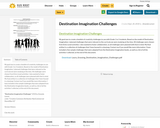
This video highlights Destination Canada's role in promoting Canada's tourism industry.
- Subject:
- Practical & Applied Arts
- Tourism, Hospitality & Entrepreneurship
- Material Type:
- Open Access Asset
- Author:
- Destination Canada
- Date Added:
- 10/31/2024

This video highlights Destination Canada's role in promoting Canada's tourism industry.

My goal was to create a booklet of creativity challenges to use with Grade 1 to 3 students.
Based on the model of Destination Imagination, I planned challenges that were relevant to the
curricula we were studying at the time. All challenges were chosen from Entry Level activities. I also wanted to foster collaboration, so all challenges were planned with that in mind. My final
artifact is a collection of challenges that I have housed in a duotang. Contact me if you would
like more information. I have included a few sample challenges that were adapted from the
Destination Imagination books, as well as a list of all the activities I collected, at the end of this
document.

Students acquire a basic understanding of the science and engineering of space travel as well as a brief history of space exploration. They learn about the scientists and engineers who made space travel possible and briefly examine some famous space missions. Finally, they learn the basics of rocket science (Newton's third law of motion), the main components of rockets and the U.S. space shuttle, and how engineers are involved in creating and launching spacecraft.

Students are introduced to detail drawings and the importance of clearly documenting and communicating their designs. They are introduced to the American National Standards Institute (ANSI) Y14.5 standard, which controls how engineers communicate and archive design information. They are introduced to standard paper sizes and drawing view conventions, which are major components of the Y14.5 standard.

Students are introduced to the unit challenge: To develop a painless means of identifying cancerous tumors. Solving the challenge depends on an understanding of the properties of stress and strain. After learning the challenge question, students generate ideas and consider the knowledge required to solve the challenge. Then they read an expert's opinion on ultrasound imaging and the potentials for detecting cancerous tumors. This interview helps to direct student research and learning towards finding a solution.

A vital aspect of a forensic investigation may be to detect and locate specific people or substances of interest, ranging from illegal drugs to missing people to clandestine graves. Sophisticated detection equipment does exist, however this technology can often be expensive, have unsuitable portability, and may even prove useless when searching vast areas. Fortunately for investigators, there is an ideal tool available. Dogs, sometimes known as K9s or sniffer dogs by law enforcement professionals, have played an important role in legal investigations for decades, with their keen sense of smell being harnessed to aid investigations. The average human being has roughly five million sensitive cells within the nose to aid in scent detection. This appears to be a large number, until compared with the 200 million cells in the average dog’s nose. Further increasing the canine’s sense of smell is an organ in the roof of the mouth that is not present in humans. This organ essentially allows the dog to ‘taste’ a smell, thus strengthening its ability to detect odours. Canines detect odours directly from the source or residual scents; odours which persist in an area after the original source is no longer present. Obviously the air is full of a vast variety of different odours, many of which will be powerfully clear to the dog. Fortunately they are able to distinguish between different odours, even if one smell overpowers another, and trace a specific scent to its source.
Also included:
-Drug Detection
-Explosives Detection
-Arson Dogs
-Cadaver Dogs
-Search & Rescue Dogs
-Tracking Dogs
-Training
-Fieldword

This short video and interactive assessment activity is designed to give fourth graders an overview of length (english units).

This short video and interactive assessment activity is designed to teach fourth graders about using real maps (english lengths and distances).

This short video and interactive assessment activity is designed to teach second graders about using real maps (english lengths and distances).

This short video and interactive assessment activity is designed to teach second graders an overview of elapsed time.

This short video and interactive assessment activity is designed to teach third graders an overview of telling time to 1-minute intervals.

This short video and interactive assessment activity is designed to give fourth graders an overview of elapsed time.

Students quantify the percent of light reflected from solutions containing varying concentrations of red dye using LEGO© MINDSTORMS© NXT bricks and light sensors. They begin by analyzing a set of standard solutions with known concentrations of food coloring, and plot data to graphically determine the relationship between percent reflected light and dye concentration. Then they identify dye concentrations for two unknown solution samples based on how much light they reflect. Students gain an understanding of light scattering applications and how to determine properties of unknown samples based on a set of standard samples.

Students use two different methods to determine the densities of a variety of materials and objects. The first method involves direct measurement of the volumes of objects that have simple geometric shapes. The second is the water displacement method, used to determine the volumes of irregularly shaped objects. After the densities are determined, students create x-y scatter graphs of mass versus volume, which reveal that objects with densities less than water (floaters) lie above the graph's diagonal (representing the density of water), and those with densities greater than water (sinkers) lie below the diagonal.

This short video and interactive assessment activity is designed to teach fourth graders about elapsed time in a sequence of events - word problems.

Resources for using "Determining Importance" as a reading strategy in the classroom.

This short video and interactive assessment activity is designed to teach third graders about determining unknown angles in parallelograms.

This short video and interactive assessment activity is designed to teach third graders about determining unknown angles in trapezoids.

This short video and interactive assessment activity is designed to teach third graders about determining unknown angles within rectangles and squares.

In this problem-based learning (PBL) activity, students take on the role of a student research scientist and explore the role of solar energy in determining climate, focusing on the urban heat island effect. Students conduct research and compare temperatures between two cities, and determine the factors that are responsible for the difference exhibited between them. The lesson is supported by teacher notes, answer key, glossary and an appendix with information about using PBL in the classroom. This is the third of three activities in Investigating the Climate System: Energy, a Balancing Act, and serves as an authentic assessment for all three modules.